FTA (изд-во). Flexography: Principles And Practices. Vol.1-6
Подождите немного. Документ загружается.

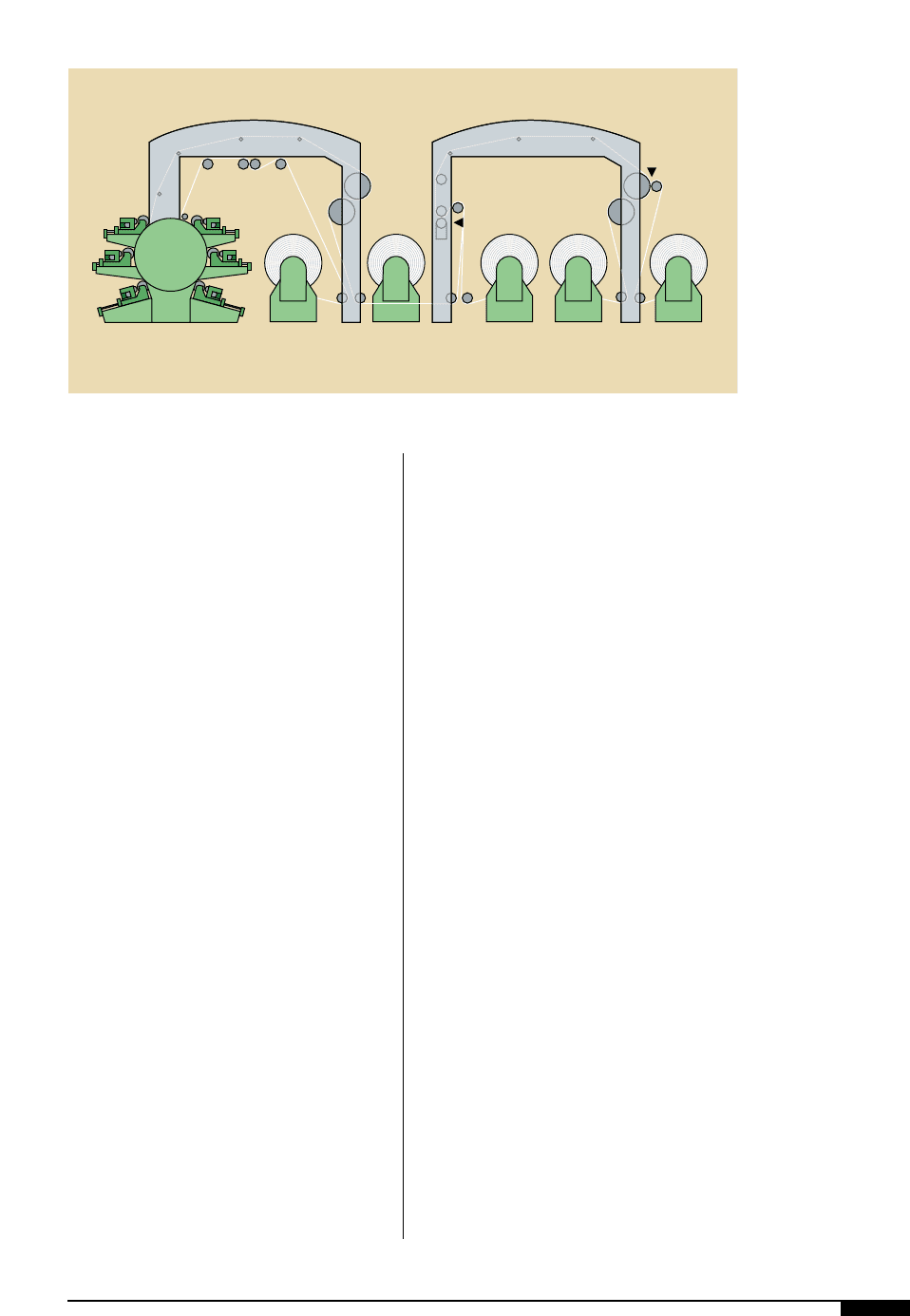
PRESSES AND PRESS EQUIPMENT 93
Lamination Nip. If the press has two chill rolls,
the first may be made into the laminating nip
by adding a rubber impression roll. If the press
has only one chill roll, another roll is needed
to form the laminating nip. This roll should be
about 14" in diameter and bored for heating. It
should be driven at the same speed as the chill
roll, preferably with a variable speed drive.
Heating of the roll can be by hot oil or hot
water, as most film laminations are performed
at temperatures less than 175° F. Hot water is
desirable in that it is cleaner than oil. Also,
switching from hot water to cold water pro-
vides another chill roll when not laminating.
A rubber-covered nip roll is required to sup-
ply the laminating pressure. This roll should
be a minimum of 6" in diameter and covered
with 80–85 durometer rubber, 1" thick. The
roll should be hydraulically or air operated to
apply variable laminating pressures up to a
maximum of 100 lb/in
2
, and should be located
so that the web has at least a 90° wrap on the
steel roll after laminating.
Adhesive Application. Immediately following
the adhesive application station, which is
the last press color station, a 2" diameter
chrome plated steel roll is needed. The pur-
pose of this roll is to smooth the adhesive to
improve laminating clarity. The roll should
be adjustable to the web and driven in
reverse rotation to web direction. A small air
motor is adequate for this function.
If the adhesive is to be applied by a flexo
print unit, the rubber transfer roll on the
plate cylinder must be solvent-resistant and
have good release properties.
To apply the adhesive by gravure in the last
color station, a gravure roll, rubber impres-
sion roll (plate-cylinder position), doctor
blade and change gears for the color station
are needed. The web must pass up between
the gravure roll (anilox roll position) and the
impression roll (plate-cylinder position).
Consequently, change gears are required to
change the direction of rotation of these two
rolls. The doctor blade attachment should
have adjustments for angle and pressure of
wiping, and an air or hydraulic motor for
oscillation. The attachment is mounted in the
area normally occupied by the flexo rubber
fountain roll. The ink pan must be modified
in order to supply adhesive to the gravure
roll. To cut down on the expense of rubber
impression rolls, rubber sleeves can be
placed on existing plate cylinders.
Separate Laminator Section
The next generation of in-line laminating
incorporated a separate and self-contained
laminating machine in-line with the flexo
press (Figure
6!
). It is independent of the
press except that it, and the press, use the
Laminator
Lamination
Unwind
Laminated
Rewind
Printed
Unwind
Print
Unwind
Print
Rewind
Central Impression
Press
Adhesive Applicator
6!
6!
This In-line laminating
setup incorporates a
separate and self-
contained laminating
machine in-line with
the flexo press.
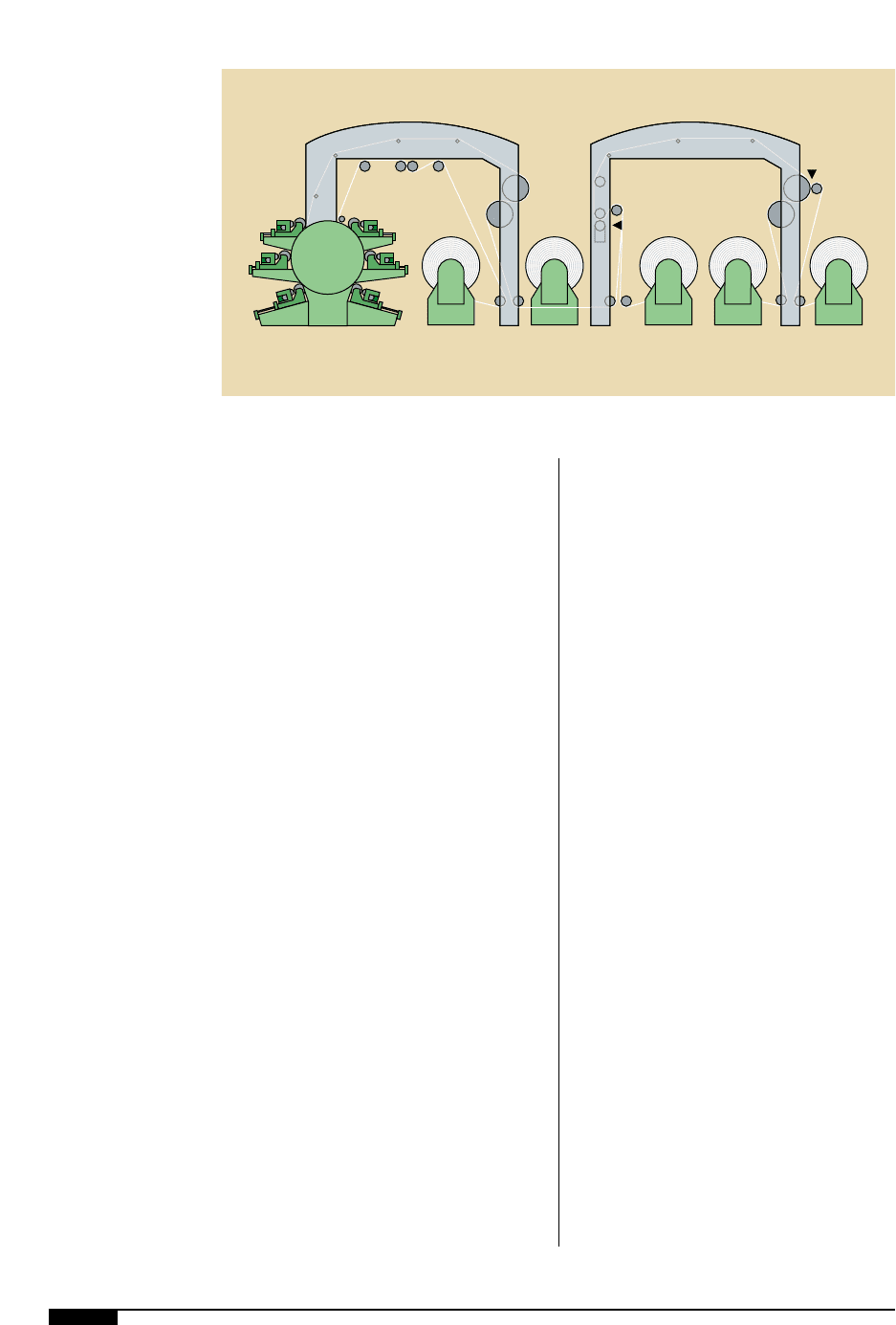
6@
A flexo press with a
separate laminator
allows the converter
to use both machines
in tandem or independ-
ently, thus offering a
wide variety of
applications.
94 FLEXOGRAPHY: PRINCIPLES & PRACTICES
same rewind, and the electric drives of the
two machines are connected and employ
necessary web tension controls. The lamina-
tor consists of a gravure-type adhesive appli-
cation station, with a smoothing roll, drying
tunnel of sufficient length to dry the web at
printing speed, laminating nip, chill roll(s)
and unwind equipment for the primary and
secondary webs. With this type of setup for
in-line laminations, several precautions must
be taken:
• The web travel between the two mach-
ines and to the rewind should be as
short as possible to prevent loss of web
control.
• The electrical and mechanical drive sys-
tems that synchronize the laminator to
the press must be of the highest quality
with adequate web tension controls to
maintain precise control of the web
throughout the operation.
• The adhesive application station must
be tied into the press functions so that
when the press stops, the nip opens and
the applicator roll continues to rotate.
Automatic or manual controls can be
incorporated for engaging the adhesive
application station.
• The above functions must also be incor-
porated into the laminating machine
drying tunnel controls. When the press
stops, the drying temperatures must be
reduced to prevent damage to the web
in the tunnel.
• The laminating station must also auto-
matically open at press stop to prevent
damage to the rubber impression roll,
as well as the web. Independent control
for closing the nip at press start-up is
acceptable.
For the converter who has a large volume of
laminating with printing, the machine arrange-
ment shown in Figure
6@
could be used. It
shows the press and laminator completely
separated except for electrical and mechani-
cal controls, which can be operated individu-
ally or in tandem. This arrangement allows the
converter to laminate in-line with printing,
print without laminating, laminate without
printing, or use both machines at the same
time but independent of each other.
Solid Adhesive Laminating
With the advent of 100% solid adhesives for
film laminations, the interest in in-line lami-
nating has greatly increased. Using the 100%
solids (solventless) adhesives eliminates dry-
ing requirements and consequently reduces
the overall length of the machine. Also,
greater printing and laminating speeds can
be obtained since the problem of insufficient
Laminator
Lamination
Unwind
Laminated
Rewind
Printed
Unwind
Print
Unwind
Print
Rewind
Central Impression
Press
Adhesive Applicator
6@
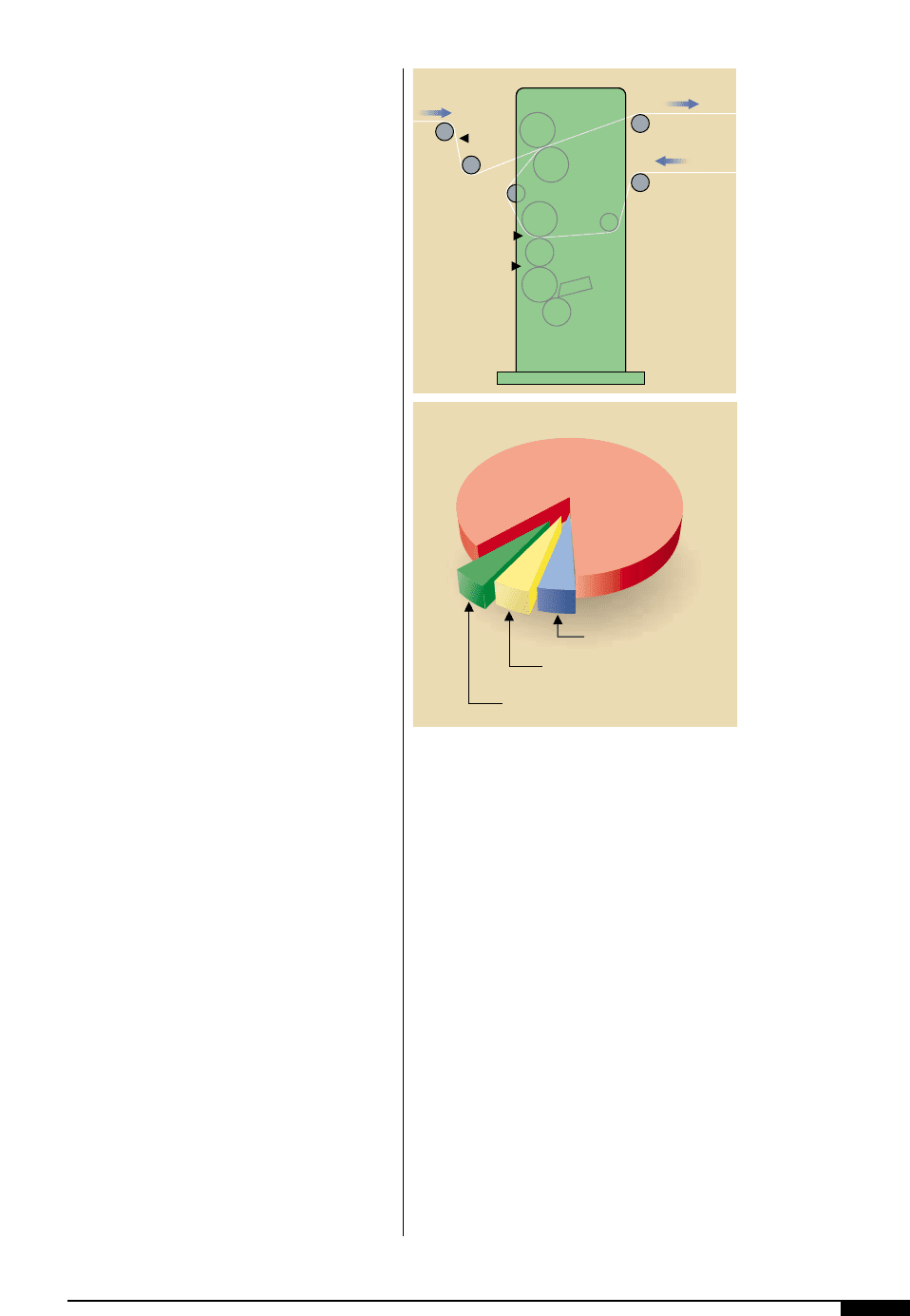
PRESSES AND PRESS EQUIPMENT 95
drying, or trapped solvents, is eliminated.
Figure
6#
shows the adhesive application
and laminating unit of a solid adhesive lami-
nator, and it is readily seen that this unit
lends itself to in-line operations. However,
turning bars must be installed between the
press and laminator if it is desired to have
the printing sandwiched between the two
webs. This laminator can be arranged as dis-
cussed in Figures
6!
,
6@
and
6#
. Due to the
nature of solid adhesives, they require spe-
cial application methods that eliminate the
use of the last station on the flexo press.
The same economic forces that are pushing
the expansion of laminating in-line with flexo
printing are also leading to the development of
various in-line coating processes such as:
• overall heat seal coating;
• thermal-stripe heat seal coating; and
• co-adhesive latex, both overall and reg-
istered heat seal coating.
In general, the same production limita-
tions and precautions outlined for laminat-
ing should be followed when considering in-
line coating with a flexo press.
UV/EB VARNISHING
Varnishes that can be cured with ultravio-
let light have gained tremendous popularity.
The flexographic process is well suited for
applying such varnishes over the entire
printed surface, or selectively where needed.
The most important aspect of applying a UV
coating is to ensure that inks laid down pre-
viously (in-line) are completely dry before
the UV varnish is applied over them.
Without going into specific details of their
chemical nature, UV varnishes are com-
posed of 100% solids (no volatile compo-
nents), all of which have to be cured. A typi-
cal composition is illustrated in Figure
6$
.
• 85% resin (mixture of viscous
and highly viscous resins);
• 4%–6% photoinitiators;
• 5%–7% wax;
• 2%–6% other supplementary
ingredients.
The selection of resins determines the
flexibility of a varnish coating. Some resins
form a flexible surface but remain rather
sticky. Others form a relatively hard, brittle
surface that cracks during scoring or bend-
ing of the substrate. It is therefore important
to perform tests on different substrates with
different coating film thickness before large
production runs are undertaken.
Curing
UV curing units (polymerization units) are
designed to cure printing inks, varnishes,
and plastic coatings. Intensive UV radiation
Printed
Web
To Rewind
Secondary
Web
Laminator
Adhesive
Applicator
Adhesive
Supply
Adhesive
Metering
6#
Photoinitiator 4% to 6%
Wax 5% to 7%
Other supplementary
ingredients 2% to 6%
Resin 85%
6$
6#
An adhesive and lami-
nating unit of a solid
adhesive laminator.
This type of setup can
be easily placed in-line
with a flexo press.
6$
A typical makeup of a
UV varnish.

96 FLEXOGRAPHY: PRINCIPLES & PRACTICES
causes polymerization and curing in a very
short period.
UV/EB curing makes use of ultraviolet
(UV) light or electron beams (EB), respec-
tively, to polymerize a combination of
monomers and oligomers. The UV/EB mate-
rial may be formulated into an ink, coating,
adhesive or other product. The process is
also known as radiation curing because UV
and EB are radiant energy sources. The
energy sources for UV and visible light cur-
ing are typically medium pressure mercury
lamps, pulsed xenon lamps or lasers. The
coatings cured by these light sources are
usually clear or translucent, though thin
opaque coatings are also possible. Electron
beam accelerators are used to generate the
electron stream capable of curing thicker,
pigmented coatings. Unlike photons of light,
which tend to be absorbed mainly at the sur-
face of materials, electrons have the ability
to penetrate through matter.
For UV curing, UV radiation (light) must
be generated. With a mercury lamp, the light
is generated by heating mercury droplets in
a sealed quartz tube to a gaseous ionized
state. When excited to an ionized gas form,
mercury naturally emits radiation in the
ultraviolet frequency. Either an electrical
current or microwave radiation can be used
to vaporize the mercury. Polished reflectors
are used to direct the light at the web. For
better, deeper or faster curing of some col-
ors or of some specialty formulations, other
materials may be added to the mercury in
the lamp to alter the spectral “signature” or
profile of the emitted light.
The quartz tube and reflector are con-
tained in a chamber called an irradiator. In
most cases, the chamber will also contain
some means to block energy from the web
when it is stationary. Blocking when the web
is stopped is required because of the high
operating temperature of the lamp, and
because a large amount of infrared (IR)
energy is also emitted from the UV lamp and
directed at the web by the reflector. Various
designs are used to block the energy, includ-
ing shutters and rotating reflectors. Some
lamp designs can be instantly turned off and
back on, making shutters unnecessary.
Safety
Ultraviolet radiation burns the skin and
can cause temporary blindness. For this rea-
son, the curing chambers, or irradiators,
must be tightly constructed to avoid light
escaping in any direction other than toward
the web. Additionally, light shields are often
used to prevent the press operator from
looking into the irradiator, and to prevent
exposure to light reflected by the web.
UV Lamp Cooling. The high temperatures in
the irradiator require that some form of heat
management be incorporated into the
design. The most common methods used to
cool the irradiator and its components are to
blow or pull air through the housing. Some
designs use water cooling. Both air and
water cooling are effective means to control
the internal and external temperature of the
irradiator. Neither address the issue of web
temperature, which is another heat manage-
ment issue of importance to the printer/con-
verter. Because of the large amount of
infrared energy associated with UV systems,
web temperatures may be elevated beyond
acceptable levels in some applications.
Elevated temperatures are most common in
film applications, but can also be an issue
with paper products, especially if multiple
UV lamps are used.
There are three possible strategies to
control web temperature. The first is to
remove the heat from the web. The second
is to avoid heating the product. The third is
to do both. Removing heat from the web
usually requires some form of heat sink, or
chill drum. Chill drums transfer heat,
through contact, from the web to a roller or
series of rollers. The rollers are cooled
with air or water to maintain their capacity

PRESSES AND PRESS EQUIPMENT 97
to transfer heat. The chill drum(s) may be
located at the point of exposure to UV and
IR energy, or downstream from that point.
The temperature that the web can tolerate,
and the temperature rise created by the UV
system, determine the location of the chill-
ing mechanism.
There are a number of ways to reduce or
limit the amount of heat put into the web.
Simply running the lamp system at a low
power level will significantly reduce web
temperature. Increasing press speed will
also reduce web temperature since it will
decrease the exposure time of the web to the
IR energy. Beyond these steps, which often
may not be possible in a production environ-
ment, the UV system may be designed to
limit the amount of IR energy reaching the
web. For example, the diameter of the lamp
determines the amount of IR radiation that is
emitted and the shape of the reflector
defines the concentration of the IR radiation
on the web. Each factor therefore, will affect
the degree of temperature rise of the web.
Air Filters. Another method to restrict the
amount of IR energy reaching the web is to
use filters that affect some portions, or
wavelengths, of energy and not others.
These filters are made from dichroic coat-
ings or materials. A dichroic coating on the
reflector either absorbs or transmits IR radi-
ation while reflecting UV radiation toward
the web. Filters placed between the bulb and
the web transmit UV radiation and reflect IR.
Water may be used as the filtering material,
but more typically, a dichroic material is
used. These filters normally reduce the peak
temperature of the web to an acceptable
level. However, the cumulative effect of mul-
tiple lamp exposures may still result in unac-
ceptable temperature increases. Combining
dichroic filters with methods to remove
residual heat from the web is required in
these situations.
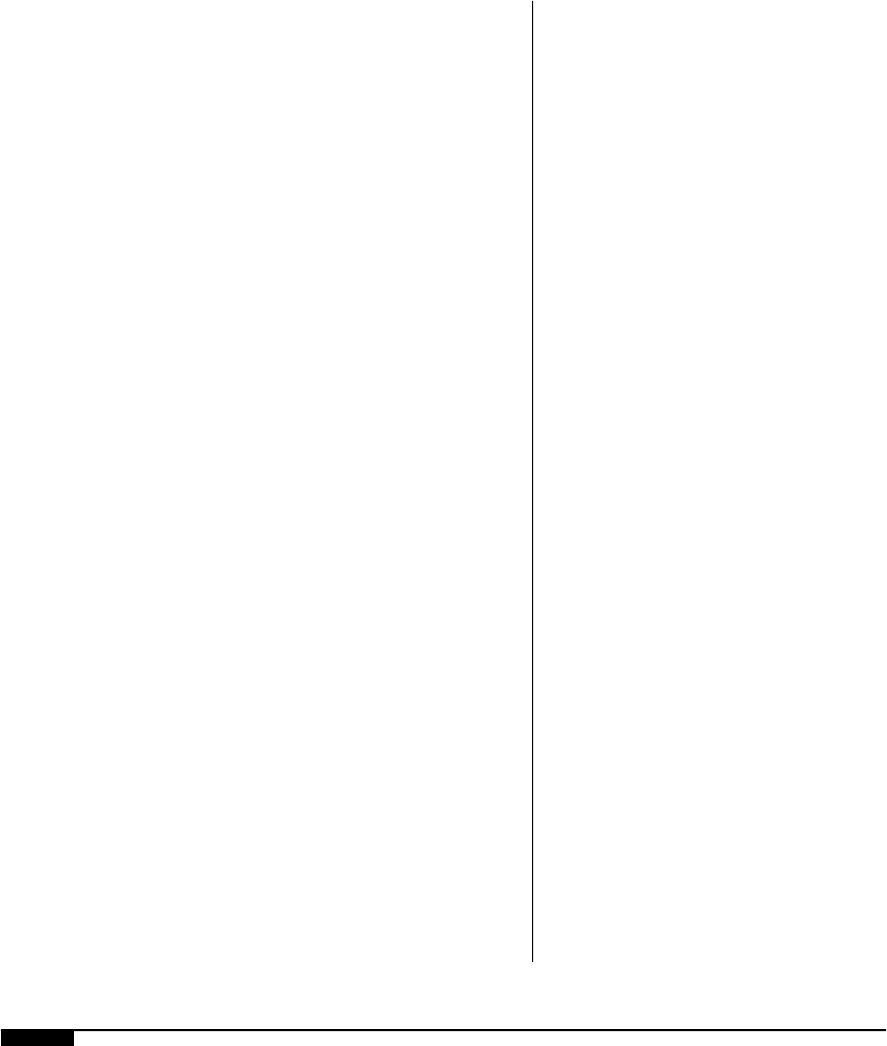
98 FLEXOGRAPHY: PRINCIPLES & PRACTICES
C
orrugated single-faced board or
combined sheets have been
used in the packaging industry
for over a hundred years. In
1871, an American, Albert L.
Jones, received a patent for
improved corrugated packing paper. From
the outset, the material was recognized for
its strength and cushioning characteristics,
but certainly not for its ability to receive a
printed image. None of the printing equip-
ment in existence could efficiently print on
this spongy packaging substrate.
BEGINNINGS
Crude machinery was used to produce
corrugated board and for decades the world
identified brown boxes or shipping contain-
ers as replacements for wooden crates. After
World War II, some machinery manufactur-
ers, as well as some board converters, start-
ed to build printing units to complement in-
line corrugated converting operations.
Letterpress printing came into existence
around the turn of the century and is still
utilized today for certain display work. The
oil-based inks used in letterpress, however,
take many hours to dry and special mea-
sures are needed to prevent smearing, stick-
ing or offsetting. This method of printing
has always been, and still is, a bottleneck in
corrugated converting plants. The corrugat-
ed industry was truly waiting for the arrival
of flexography, a means to mark or rotary-
stamp corrugated boxes.
EVOLUTION AND GROWTH
In those early days, no one anticipated that
graphics on corrugated board would evolve
much beyond the most basic techniques.
The first flexographic in-line machines, built
in the mid-to-late 1950s, printed one color,
almost without exception black. Compared
to other industries (tag and label, cups, etc.)
corrugated flexo received little recognition
well into the 1970s.
Printing on combined corrugated board
continued to receive little recognition and
seemed to have little potential for producing
high quality, multicolor graphics. When
process printing was mentioned, it produced
blank stares, or a rebuffing laugh, at best.
To d a y, the sheet-fed freestanding flexo press
for corrugated has developed into a high-
tech “marvel,” producing results that rival
lithographic label and preprint quality.
MARKETS FOR FLEXO PRINTING
The predominant market in the corrugated
industry has always been, and remains today,
the so-called “brown box” market. The major-
ity of linerboard produced on paper making
machines worldwide is brown paper, mean-
ing virgin and recycled kraft paper. A figure of
90% to 93% may be used to quantify this seg-
ment of the total linerboard production.
The remaining 7% to 10% is bleached, clay-
coated, often called "mottled white" paper, or
white top sheets. It is this small segment that
is of primary interest to the high-quality flex-
ographic preprinter or postprinter. This is not
C o r r u g a t e d
Postprint Presses
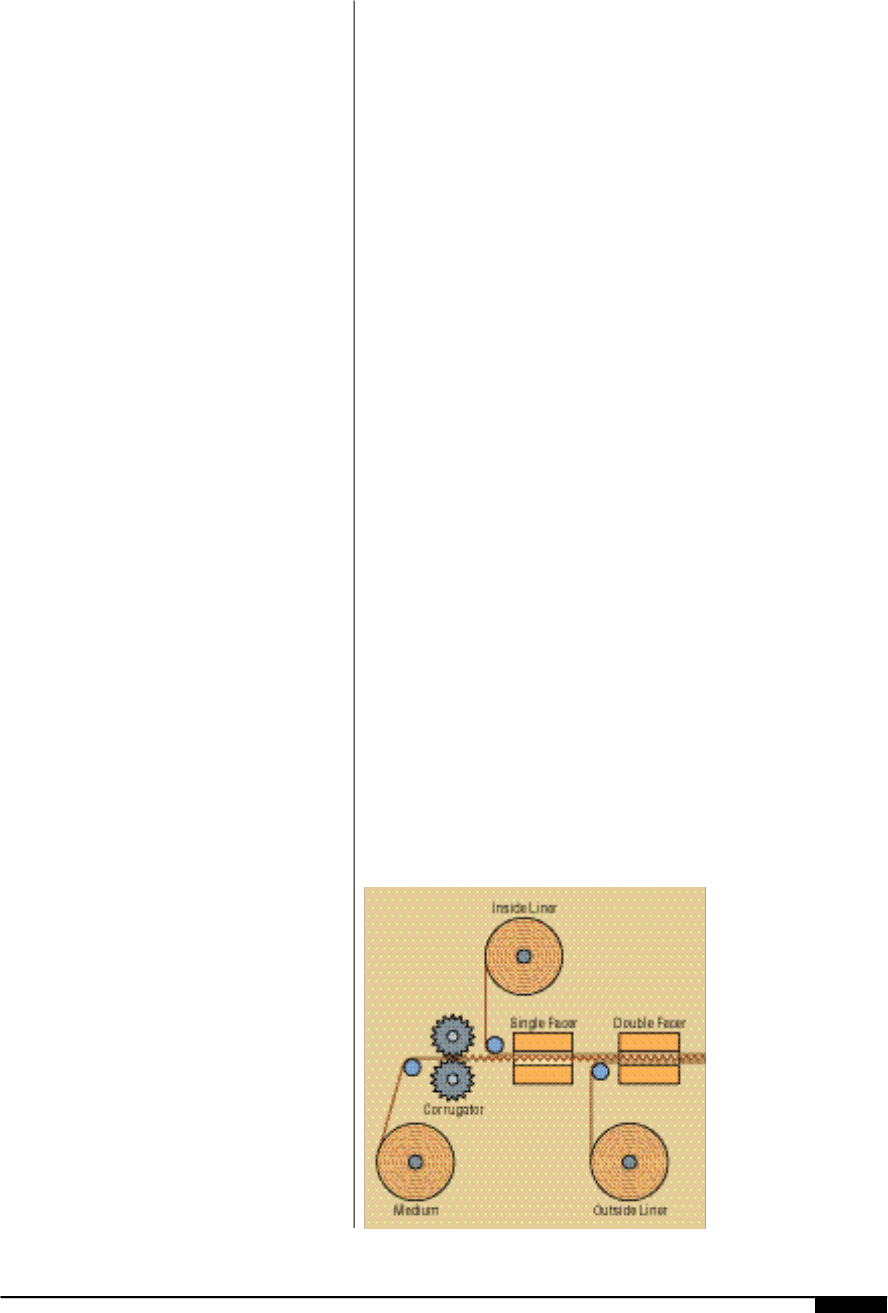
PRESSES AND PRESS EQUIPMENT 99PRESSES AND PRESS EQUIPMENT 99
to say that brown liners are not conducive to
so-called “value-added printing.” In fact, the
contrary is true. Brown boxes almost always
contain some printing, and in fact, even mul-
ticolor halftone screens are found on brown
boxes. In some cases this is achieved by tint-
ing the board with a white coating on the cor-
r u g a t o r, or by printing a white background
with titanium dioxide-based white flexo ink.
It is safe to say that a very large quantity of
brown boxes, or shipping containers, are pro-
duced with value-added graphics and point-
of-purchase messages.
The crossover from flexographic printing
on brown kraft liners to white-top or coated
liners, as well as bleached liners, is by no
means the frontier for high graphics or
value-added printing. It is therefore difficult
to establish statistics that clearly differenti-
ate between a high-graphics operation and a
"brown box" operation. One can also not
classify value-added or plain brown box
printing by the type of printing equipment
used. Value-added graphics are categorized
primarily according to their quality and have
therefore no significant connection as to
what substrate they are printed on or with
which type of machine they are printed.
PREPRINTING VS. POSTPRINTING
The terms preprinting and postprinting are
used to describe when the printing is per-
formed in the corrugating process. A corru-
g a t o r, in its basic version, produces single-
faced board, consisting of the medium (the
corrugated paper) onto which a liner is
glued. This first liner is called the single-face
l i n e r, which is never, or very seldom, printed.
On this same corrugator, another liner is
glued on the opposite side, on the tips of the
fluted or corrugated medium. This liner is
called the double-face liner (Figure
6 %
) and
may be printed on wide-web flexo presses
before it is applied by the corrugator. We call
this process preprinting, i.e., the printing has
taken place before the combining process.
In the preprinting converting process, the
web of double-faced board is cut into sheets
in register with the printing on the double-
face liner and stacks of preprinted sheets are
produced for subsequent converting into
containers, boxes or die cuts. In some cases,
the printing and die-cutting units are incor-
porated into the corrugating line.
It is noteworthy to mention that preprinting
in the corrugated industry has been in exis-
tence for less time than postprinting. Flexo-
graphic preprinting, first introduced in the
United States on a large commercial basis 20
years ago by a company in Wisconsin, has
grown to tremendous output capacity.
Preprint methods other than flexo, such as
offset and rotogravure, are also utilized. The
preprinting onto linerboard process lends
itself to more refined graphics; however, rela-
tively large press runs are needed to make it
cost-effective. The cost of preprinting short
run promotional graphics is prohibitive
To d a y, there are approximately 45 to 50
preprint presses for linerboard operating in
North America.
Postprinting, as the term defines it, is per-
formed on combined double-face corrugated
sheets after the corrugating process. The
postprint process lends itself readily to the
6%
In corrugated pre-
printing on wide-
web flexography,
the double-face liner
may be printed before
it is applied by the
corrugator.
6 %
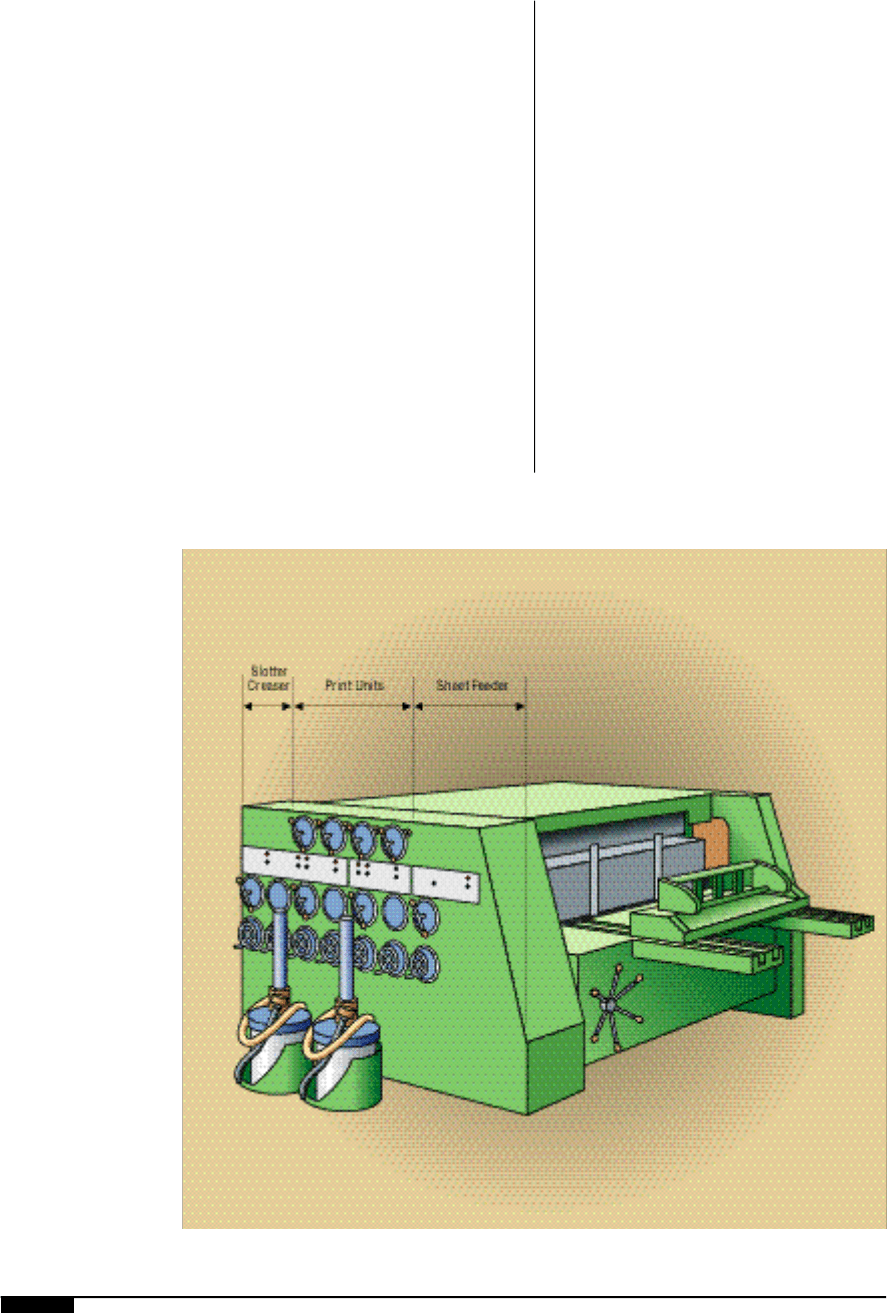
“just in time” manufacturing methods being
adopted by today’s industries.
Economics of Postprinting
Postprinting is by far the most common
method for printing on corrugated. A con-
servative estimate is that there are over
10,000 flexographic printing units of one
kind or another in use in integrated and inde-
pendent corrugated converting plants.
The economic advantages of flexography
on corrugated depend largely on what level
of flexographic printing is performed. For
example, profit margins in brown box plants
can only be achieved if the printing process
is performed at the highest possible produc-
tion speeds, e.g., 600–800 linear feet/minute
or 10,000 boxes/hour. Printing, which is per-
formed in-line, should never slow down the
converting process. On the other hand,
when manufacturing high-quality display
work or halftone-process screen work, the
profit margin depends on how much cheap-
er the printing operation can be performed
compared to labeling or laminating, while
maintaining acceptable quality.
Generally speaking, the medium and
linerboard raw materials constitute the
biggest cost share in any corrugated plant.
By the time the flexo printer receives com-
bined sheets on the printing press, the
sheets represent more than 80% of the
value compared to the final selling price.
When clay-coated or bleached liners are
used, the basic material cost (raw materi-
al) is, of course, even higher.
6^
A typical corrugated
postprint press today
can handle printing
boxes from finished
sizes of 7.5" x 13.5" up
to 104" x 210".
100 FLEXOGRAPHY: PRINCIPLES & PRACTICES
6 ^

PRESSES AND PRESS EQUIPMENT 101
Flexographic postprinting, because of its
inherent simplicity and high-speed produc-
tion capabilities, remains the preferred
method for producing graphics of any level
at a reasonable profit.
RANGE OF PRODUCTS
From the beginning, corrugated shipping
containers, which replaced wooden crates,
in sizes from 4" x 4" up to triple-wall contain-
ers (which may be used today to pack the
body of a car) required marking or stamping
for identification purposes. Such markings
included a minimum of information such as:
“Do Not Drop,” “This Side Up,” or an umbrel-
la graphic warning against exposure to the
sun. The printed markings also sometimes
listed the contents in large bold text, and
only rarely were illustrations of the packed
merchandise shown on the outside of the
box or container. To d a y, there are very few
markets, from food production to computers
and appliances, that do not utilize the power
of graphics on corrugated shipping contain-
ers and point-of-purchase displays.
The brown box or container is, by a large
margin, the most common type of corrugat-
ed container. Sheet sizes needed to produce
such boxes and containers may range from
7.5" x 13.5" up to 104" x 210". Flexo printing
equipment for the entire size range exists
today (Figure
6 ^
) .
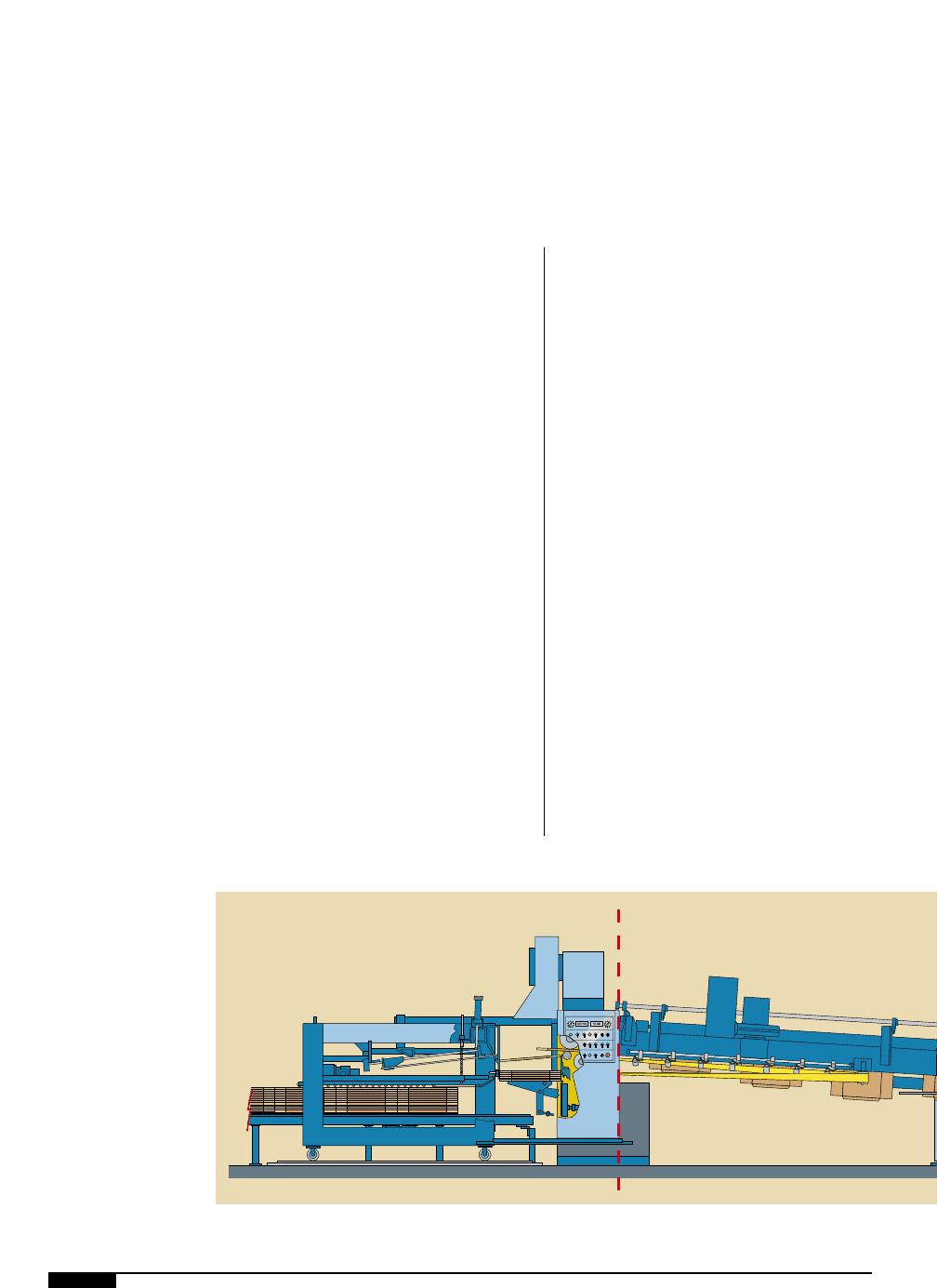
102 FLEXOGRAPHY: PRINCIPLES & PRACTICES
Repeat orders of medium-to-long runs lend
themselves especially well to such in-line
production. Today’s flexo folder-gluer or
rotary die cutter is generally equipped with
up to four printing units, which can offer
more intricate graphics and also accommo-
date two-color work. In the case of two-color
work, while two units are printing, two oth-
ers can be prepared for very quick job
changeovers, especially on small runs.
The close coupled printing units of the
printer/rotary die cutter and flexo folder-
gluer machines have so-called roll-away units
on tracks (Figure
6*
) to permit access to var-
ious printing elements for setup or wash-up.
The advantages of producing regular slot-
ted cartons on a flexo folder-gluer, at ever-
increasing production speeds, are well
known and appreciated in the corrugated
converting industry. The disadvantages of in-
line flexo printing at most types of convert-
ing operations are: dust, frequent printing
plate washing, limitations in print coverage,
and limited placement of graphics to avoid
Press Construction
I
n the corrugated industry, many compo-
nents of the flexo printing process
remained crude until parallel industries
started to introduce new plate materials
such as photopolymers, cushioning
materials, modernized inking systems,
and mechanically engraved anilox rolls
(which today are increasingly being replaced
by laser-engraved rolls).
The most appreciated characteristic of
flexo printing on corrugated is its simplicity.
The thick, soft, flexible plates, which adjust
easily to a relatively uneven substrate,
together with the fast-drying inks, allow in-
line printing to be combined with a multitude
of other converting processes in a single
operational step.
Flexographic printing units, whether on
flexo folder-gluer machines, or in-line with
rotary die cutters or with platen-type die cut-
ters, allow converters to produce boxes, con-
tainers, regular slotted cartons, and some-
times multi-out rotary or platen die-cuts, as
an integrated manufacturing step(Figure
6&
).
Counter Ejector
Folding Section
6&
6&
In-line flexo folder-gluer
components.
